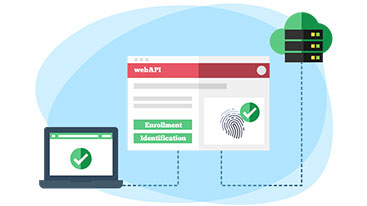Which is The Most Reliable Biometric Modality?
We recently conducted a Twitter poll: “What is considered to be the most accurate biometric modality among the following options?”
We received a large number of responses from our community reflecting the following results:
- 58% chose iris recognition
- 32% chose fingerprint
- Palm vein and facial recognition both got 5% of the votes
It’s interesting that people immediately gravitate towards iris recognition as the most accurate biometric than other modalities, with only fingerprint as a distant second. What is the reason behind the result?
As human beings we all have unique behavioral traits and physical attributes which define our individuality. Biometrics uses these unique traits as a means to individually identify people, supplanting traditional and security plagued methods of identification which may include passwords, personal identification numbers (PINs), or ID cards. Biometrics is a process which identifies and captures these unique characteristics and converts them into enrollment templates that can be later used to compare a captured physiological or behavioral characteristic for accurate identification.
Biometric “modalities” are the physical hardware devices that capture individual physiological or behaviorial characteristics and then uses these traits as input to create the aforementioned unique templates. The most common biometric modalities are fingerprint recognition, facial recognition, iris recognition, and voice recognition.
The reliability of a biometric modality depends on various factors such as environment, age, ethnicity, and skin integrity. Different industries and environments demand different types of biometric modalities based on different situations.
You also need to consider the type of modality used and how it affects system performance, cost, and limitations. Working conditions and environmental factors are vital factors to also consider because they have a direct impact on user acceptance, feasibility, and performance. The most important factors to consider when researching the appropriate biometric modality include:
- Accuracy
- Security
- Availability
- Ease of use
- Anti-spoofing capabilities
- User acceptance
- Usability
- Cost
- Hygiene
- Return on investment (ROI)
Therefore, choosing the most reliable biometric modality is a prerequisite for deployment success. Choosing the most effective modality is the only way to get the most out of your deployment by providing you the opportunity to maximize efficiency, benefits, and return on investment (ROI).
To help make the process easier, we have provided you a summary of the most popular biometric modalities:
Iris Recognition:
Most survey participants picked iris recognition as the most accurate biometric modality among the choices provided, and for good reason. Iris recognition is widely considered to be the fastest and most accurate method of biometric identification that captures photos of your eyes and maps your unique iris pattern to verify your identity.
Iris recognition has a strong acceptance rate based on the non-invasiveness and non-contact, hygienic nature of the technology.
Places such as hospitals (where providing accurate care and protecting privacy are paramount) increasingly rely on iris recognition for patient identification. This modality is also used in highly secure environments like military bases, data centers, bank vaults, border security, passport checks, and national ID programs.
Examples of current iris recognition deployments include:
- UAE’s land, air, and sea ports of entry
- India’s UID Initiative where registration for the Aadhaar card includes iris recognition for multi-factor authentication
- Google uses iris scanners to for data center access control
The pros and cons of this modality are:
Pros:
- Accuracy: 1 in 10⁷⁸ chance that iris pattern of two individual matches
- Stability: The structure of the iris remains the same throughout our lifetime
- Speed: The small template size helps provide fast matching
Cons:
- Relatively expensive
Fingerprint:
Fingerprint is by far the most recognizable biometric modality around the world, but it is waning in popularity as other, more accurate, hygienic, and reliable modalities have surfaced. The uniqueness of this modality is determined by mapping the ridges and furrows of a finger.
This modality is practical and convenient to identify end users and the first commercially widespread biometric hardware which is why it is mostly used in law enforcement, forensic departments, government projects, banking, and workforce management.
Examples of current fingerprint deployments include:
- Fingerprints captured for voter registration in Nigeria
- Iraq implemented a biometric fingerprint system for border patrol security
The pros and cons of this modality are:
Pros:
- Relatively inexpensive
- Unique: Everyone including identical twins have unique fingerprint patterns
- Small template size provides fast matching
Cons
- Poor skin integrity, ethnicity, age, and environment can negatively affect results
- Easier to spoof
- Negative end user stigma associated to criminality
Finger vein and palm vein:
Finger vein and palm vein are also known as vascular biometrics. This modality is based on vein patterns and uses pattern-recognition techniques based on images of the human finger and palm vein beneath the skin’s surface.
Unlike fingerprints, due to the fact that vein patterns are an internal biometric characteristic, this biometric modality is treated as more secure than others by some experts.
Recent and current finger vein and palm vein deployments include:
- Infinite Solutions integrated a biometric finger vein recognition system to ensure accuracy and prevent data leaks
- Yarco Company, Inc. deployed the RightPunch™ finger vein PC-based biometric time clock solution with their web-based KRONOS time and attendance workforce management system
The pros and cons of this modality include:
Pros:
- High reliability and accuracy
- User-friendly modality
- Environmental factors do not have a negative effect on performance
Cons:
- Not an ideal biometric modality for child identification
- Cold weather conditions could cause recognition difficulties
Conclusion
What’s clear is that every biometric modality has its own benefits and drawbacks. Fingerprints may be the most popular modality, but iris recognition gets the highest marks for its accuracy and positive reputation as the future of biometric recognition.
Thank you to those who participated in the poll and provided us with the research for this post. Please follow us on Twitter for details on our next biometric related poll! Participate and be a part of our community!














yeah most people feel IRIS is the best but many of the clients in india are still buying finger print readers .Thanks for the survey Venkat from harithatech.com